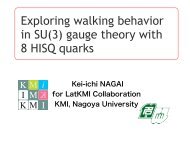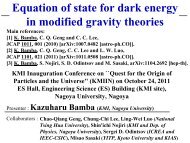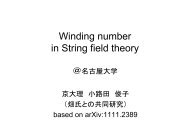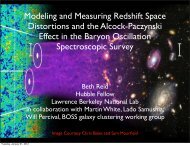Diego Saez-Gomez
Diego Saez-Gomez
Diego Saez-Gomez
You also want an ePaper? Increase the reach of your titles
YUMPU automatically turns print PDFs into web optimized ePapers that Google loves.
H(z = 0) = H 0 = 100 hkms −1 Mpc −1 ,h=0.71 ± 0.03 (5)<br />
H (z) = κ2<br />
2<br />
Scalar-tensor representation of<br />
ρ m<br />
f(r) gravity<br />
H 0 (1 + z)h(z) , → H (0) = κ2<br />
ρ 0 m = 3 2H 0 2 Ω0 m . (6)<br />
H (0) 0 (7)<br />
Hu-Sawicki model<br />
Ω m (z) , Cosmological Ω f(R) (z) evolution in viable modified(8)<br />
gravity<br />
Phase space<br />
1.0<br />
V + (φ) V − (φ) (9)<br />
0.9<br />
1.6<br />
1.4<br />
0.8<br />
1.2<br />
H 2 H 0<br />
2<br />
0.7<br />
0.6<br />
H 2 H 0<br />
2<br />
1.0<br />
0.8<br />
0.5<br />
0.6<br />
0.4<br />
0.4<br />
0.3<br />
0.90 0.92 0.94 0.96 0.98 1.00<br />
Φ<br />
(a)<br />
This branch of the potential makes the scalar field to tend to the boundary, where a<br />
sudden singularity occurs.<br />
2.0 2.2 2.4 2.6<br />
Figure 9: Phase space H(φ) for the HS model (panel 9a), where different init<br />
considered. The right panel corresponds to the NO model. For both models, the po<br />
been assumed. As observed, all the curves in both models reach DSG, Class.Quant.Grav. the bounding 30 095008 (2013) of the sc<br />
(b)<br />
Φ










